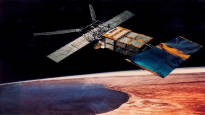The large satellite will fall down next Wednesday evening. Published by the European Space Agency on Monday at 17:30 forecast according to the calculated drop time is 17:41 Finnish time.
The uncertainty of the forecast is still around 12 hours at this stage, which means the satellite can come down faster or slow down later.
About a fifth of the satellite will make it to the ground. Most of it is destroyed when falling into the atmosphere due to the so-called frictional heating of the atmosphere. The outer parts of the satellite heat up to a temperature of over 1,600 degrees Celsius and vaporize during use.
Especially the parts designed to withstand heat and the satellite’s large radar antennas may partially survive to the Earth’s surface.
Smaller parts burn in the air and look like shooting stars. It can also rain all the way to Earth.
An estimate of where the satellite’s tendons will fall can only be obtained just before the fall. Finland is also a possible relegation zone.
One satellite less space junk
The falling satellite is the remote sensing satellite ERS-2.
It is another of the new types of remote sensing satellites sent into space by the European Space Agency in the 1990s. The name ERS comes from the words European Remote Sensing satellite.
They were able to describe the terrain below very precisely, even at night and through the clouds. The observations were used, among other things, to monitor floods and vegetation as well as to map glaciers.
ERS-1 and ERS-2 greatly exceeded their planned operating life. ERS-1 is still orbiting almost in its original orbit at an altitude of slightly less than 800 kilometers. In practice, it is therefore space debris that can, for example, crash into another satellite, which in turn increases the amount of debris.
Air traffic control changed the trajectory of ERS-2 in 2011 to lower its altitude to 537 kilometers. Then the satellite was turned off. This shortens the time it spends in idle space, as lower satellites fall faster.
A natural fall from a height of 800 kilometers takes more than 200 years, from a height of 570 kilometers only a decade.
With newer satellites, there is no need to wait because they are designed in such a way that they can be dropped directly down into the atmosphere.
The risk of being hit by a falling satellite is very small
ERS-2 orbits the Earth on a path that passes through the polar regions, which, when drawn on the map, runs in a wave-like manner between north and south. The satellite passes over Finland every day at around 5 pm (see map below).
According to the estimate made on Monday evening, the calculated drop time is 17:41 Finnish time. The satellite’s track runs over Eastern Finland and Lapland a little before this. Since the uncertainty in the fall time is still 12 hours, the satellite may also hit Finland.
Estimated overflight times also change as the satellite falls down. Only shortly before the fall into the atmosphere, the time and area of the satellite’s fall can be precisely determined.
A satellite can only fall in the areas below its orbit – not anywhere on the Earth, even though it has flown over every corner of the Earth over a long period of time.
Various authorities in Finland are monitoring the situation and will take action if ERS-2 falls near Finland.
Head of the space research group responsible for monitoring at the Finnish Meteorological Institute Tiera Laitinen stated on Friday to that the risk of damage is small even in the event that the satellite falls on Finland.
About 2,500 satellites and pieces of space debris fall from space and are dropped into the atmosphere every year.
Most of these are destroyed in the atmosphere, but then parts of a large object fall all the way down. Since most of the Earth is sea and sparsely populated areas, there is almost no harm in these.
History only knows about twenty cases where scrap has caused danger. In 1997 in Oklahoma, USA, a small piece of debris fell from the sky and hit a woman. In China, in 2002, a young boy recovered a ten-kilogram aluminum sheet that had come from a Chinese rocket.
Statistically, the risk of being hit by space debris is one in a hundred billion per year. Lightning is 65,000 times more likely to strike a person than a part of a satellite falling on the head.
The story has been updated several times with detailed fall time estimates, most recently on Monday morning.
